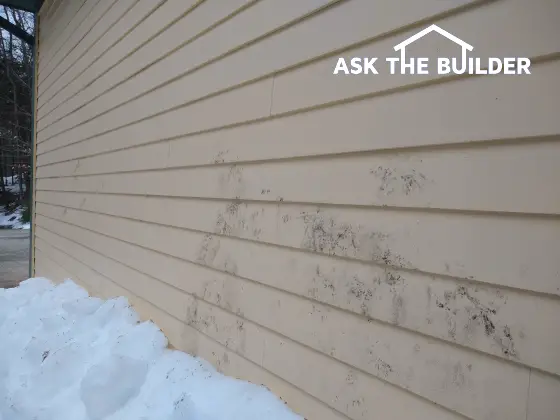
This is mold and mildew on siding. It happens on siding of all types, vinyl, wood, fiber cement, etc. (C) Copyright 2020 Tim Carter
DEAR TIM: My house is now twenty-five years old. It’s covered with vinyl siding. Every summer I have mold and mildew that develop on the north side of my house. Every few years I remove it. Is there some coating I can apply to the siding to stop the mold and mildew from reappearing? It’s aggravating. What about some sort of magic paint? I’m open to any and all ideas. Robert C., Sylvania, OH
Robert doesn’t suffer alone. I have the same exact issue here at my own home, although my house is covered with fiber-cement siding. You may have black mold and mildew or green algae growing on the north side of your home if you live north of the equator. The north exposure provides the perfect conditions for this organic growth.
Here’s the bad news for Robert, in my opinion. There’s no magic paint or coating I’m aware of that will keep his or your siding free of mildew, mold, and algae. Here’s why.
These three living organisms are just about everywhere. They just need two things to grow: water and food. The northern exposure of houses provides ample amounts of water.
It’s important to realize that direct sunlight doesn’t wash the house walls facing north. This means water is often slower to evaporate. Morning dew can and does form on all the surfaces of the house when the surface temperature drops below the dew point of the air.
Those surfaces on the north side of the house lose this dew last allowing the mold, mildew, and algae to get a drink before the next morning. The soil just below the siding stays far moister than the soil on the other sides of the house all things being equal. Water evaporates from this soil and some of this water vapor might also quench the thirst of the organisms.
Food is readily available in almost all areas of the USA for mold, mildew, and algae growth. Robert lives in Ohio where deciduous trees are as plentiful as kids at an amusement park on a sunny summer day. Some of these trees, especially maples, broadcast a fine aerosol. These microscopic drops of elixir contain sugars that are delicious food for mildew, mold, and algae.
Dust, and other pollutants, can also be food for some of these organisms. Realize that food is everywhere even though it’s invisible and you can’t see it. Old oil-based paints were made from alkyd oil resins. These oils are scrumptious food for mildew and mold!
This is why some modern deck sealers that are made using natural oils turn black in months after you go to all the work to make your deck look nice. You’re slathering on food for the mold and mildew to munch on! Some natural-oil sealers contain chemicals to slow organic growth.
Three years ago, I wrote a book, Roofing Ripoff, about why the asphalt shingles on your roof are falling apart faster than they should. The inspiration for the book came when I was the first person in the world to discover that copper ions will extend the life of asphalt shingles for decades.
Many have known for hundreds of years that copper is also an amazing natural biocide. This is why the hulls of clipper ships and Old Ironsides have copper plates on them. I’ve used liquid copper solution to keep algae off patios. The only issue is the copper washes away with each rainfall and it can create a bluish cast. Some people are very much against the use of aqueous copper like this thinking it harms the environment.
Robert may want to experiment with spraying a copper sulfate on the vinyl siding. However, if he’s got valuable landscaping or trees nearby, the copper is not going to help them live. The issue is the copper on the vinyl siding is temporary and it will wash off with repeated rainfalls.
I think the easiest thing to do, but this is not what Robert wants, is to just wash the siding once a year around Flag Day. It’s warm by then and the chore won’t be too hard. If you wash the house when the siding doesn’t yet have mold or mildew growth, you might be able to accomplish it using a garden spray attachment to your garden hose.
Instead of putting dangerous chemicals in the sprayer, just put in some powdered oxygen bleach as well as some liquid dish soap. Spray this soapy solution on the house and allow it to sit for 15 or 20 minutes. This allows the oxygen bleach to attack and breakdown any invisible food particles. The liquid dish soap lubricates the surface so any food comes off with minimal effort when you rinse the siding.
This simple cleaning procedure ensures the siding looks great all year.
Column 1336
The post Magic Mold Removal on Vinyl Siding appeared first on Ask the Builder.
Via Home http://www.rssmix.com/
No comments:
Post a Comment